In a survival situation, trapping is arguably the best way to fish.
Unlike hooks with bait or spearing, fish traps require almost no work on your part: you simply make and set the traps, leaving you free to do other tasks ( like making your survival shelter).
There are many different ways to make a survival fish trap. I’ll go over the easiest and most effective here.
1. Pot Trap (aka Plastic Bottle Fish Trap)
In a survival situation, you will be thankful for how much trash is everywhere. You can probably find a 2 liter plastic bottle and use it to make a small pot trap for small fish.
Here are instructions on how to make it:
- Cut the top off of a plastic bottle
- Invert the top of the plastic bottle and put it into the lower part of the bottle. They should fit together snugly. You might need to cut a small slit on the top part of the plastic bottle to get it inside. Poke some holes through both and tie them with string. This also serves as a handle.
- Poke some holes in the bottle for water to flow through.
To use the trap:
- Put some stones in the bottle (to act as sink weights)
- If you have bait, put it in the trap as well.
- Use the handle to secure the trap in an area where fish or frogs go. Orient the opening towards the water flow.
- Check the trap every few hours.
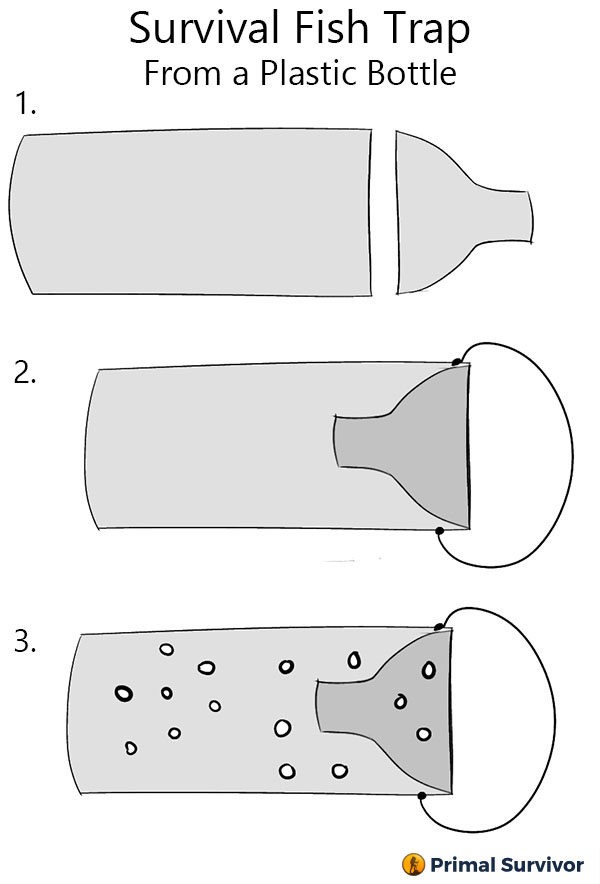
And here is what the bottle fishing trap looks like in real life.
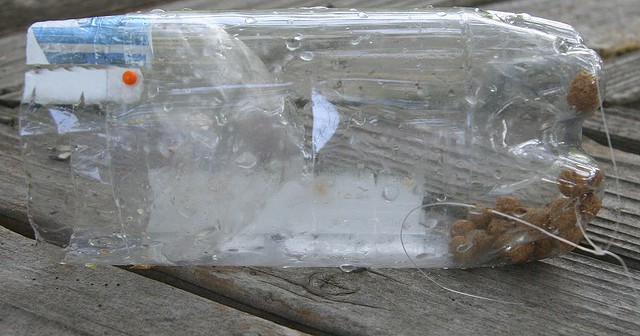
2. Fishing Weir
A fishing weir takes more time to make than a bottle trap, but it is less passive. Instead of just waiting for fish to enter, you can chase them into the weir. Or you can put the weir with the current running towards it (to catch fish as they go downstream).
The fish swim into the trap through the opening and then cannot find their way out. It isn’t as effective as using a net because some fish can still find their way out, but it is one of the easiest to make.
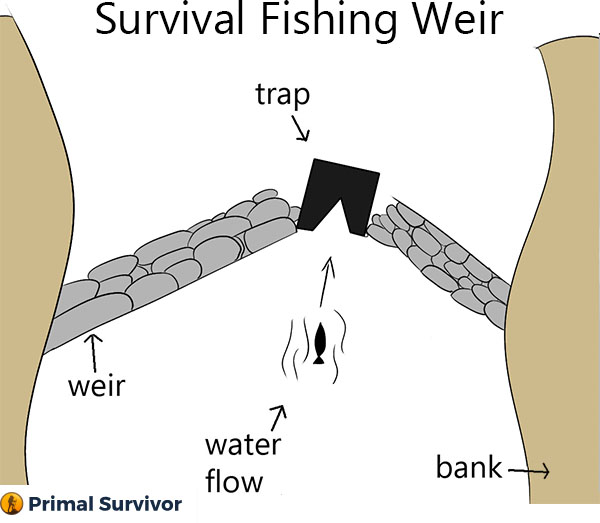
The weir can be made out of rocks, heavy logs, or even sticks pushed into the ground to make a “fence.”But you can also make a small fishing weir (like the one in the picture) at the bank of a pond or river to get small fish.
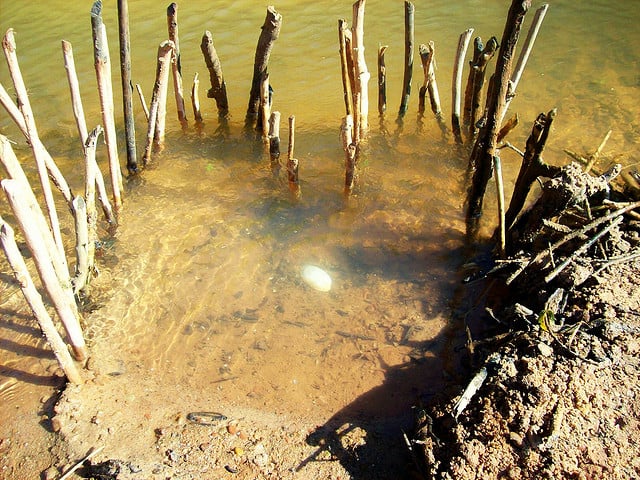
3. Seine Fishing Trap
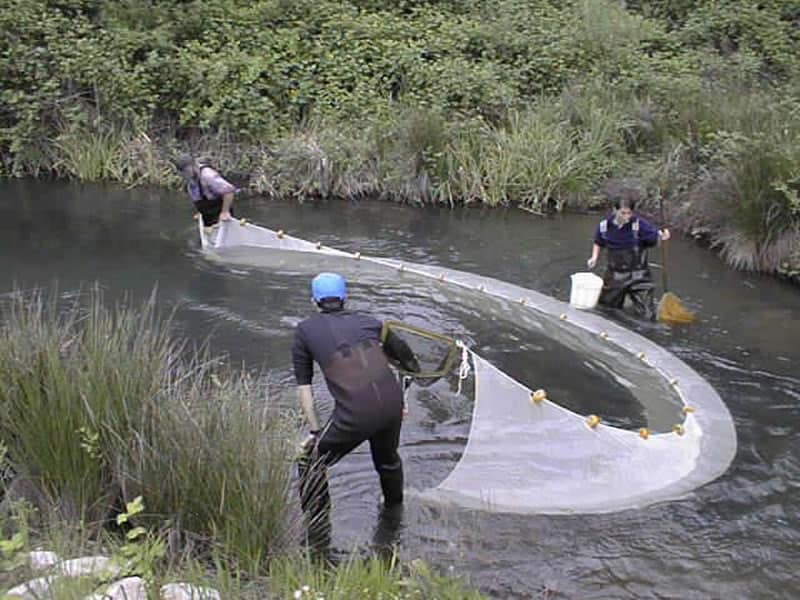
A seine is basically a big fishing net that you drag along a river or pond to catch fish. This is a very effective method of fishing and it has been used for thousands of years – including by stone age people. Like with a weir, it takes more work but is less passive.
The obvious downside to this method of survival fishing is that you will need a net.
Hopefully you will have a lot of cordage or even dental floss to make a net. Or, you can get really crafty and use natural materials to make your own cord in a survival situation.
Your net needs to be fairly long (at least a couple meters) and wide. The larger the net is, the larger of fish you will be able to get.
Tie stones (as weights) onto the bottom of the net. Tie something which floats onto the top (this can be driftwood, closed plastic bottles, or Styrofoam you find in the trash, for example).
You will need two people to operate the seine. One person holds onto each side of the seine and walks through the water. Start by walking straight forward, and then come towards each other making a C shape. It helps to have a third person to grab any caught fish in a net.
Have you ever used any of these survival fish traps? Let us know in the comments.
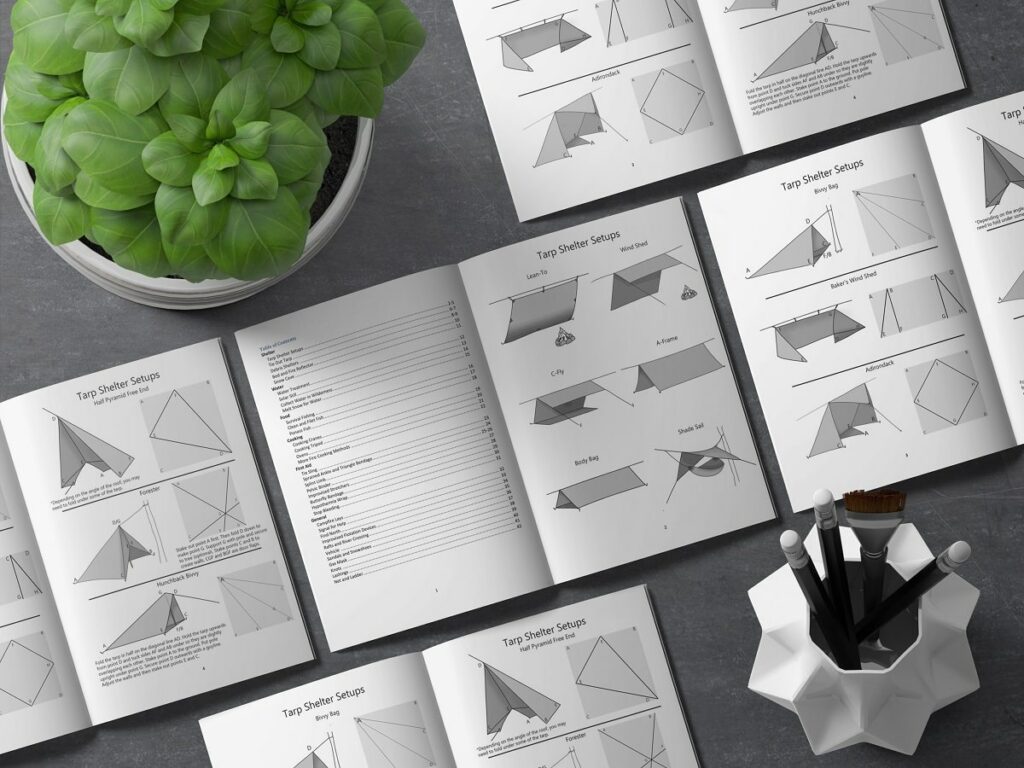

All of this info is great! We’re feelinh like this is going to be very important to know soon. Thanks to all!
Hi
Id just like to add that i think a simple trot line if hooks are available. Really like your site. Thanks.
I’ve used a bottle trap to catch fish in my aquarium. It’s a lot easier and gentler than chasing them with a net. A $2 jug from Walmart is a lot cheaper than a $60 trap from the fish supply companies.
I’ve seen a fish trap with a pit that lure the fish in. It looks good for recreation but I think a fish weir is better.
I just have to say I love this site I’m a newbie in the survival world and this site is my go to thank u
Thanks Farmer man, good to have you onboard.
A cast net is a good alternative to a seine net. It’s a circular net with weights and a sliding line around the outside edge.The net is thrown (think of a giant frisbee), drops over the target fish, and as the line to retrieve it is hauled back in closes the net around them to prevent escape. It only takes one person to operate, doesn’t need poles, and has surprise working for it since fish only have a moment to see it coming. It takes a little practice to operate, but only a little. They can be used from the shore or from a boat, and you don’t have to get wet to do it, which is nice after September or so. They’re cheap, available in different sizes and pretty light as well. If you wanted to make it lighter you could even remove the weights and replace them with small canvas sachets (reusable cotton tea bags) around the edge to add rocks to when you needed, so that you’re not carrying unnecessary weight. They also don’t need floats to work so it saves bulk in packing. If you really need to get fish though, it’s hard to do better than a treble hook and a doughball with grubs in it hanging from a float (log, bleach bottle, packing foam, whatever) tethered to the shore. You can put out multiples, and you don’t have to watch them since the float will “fight” the fish for you. Make sure you use heavy enough line and check pretty often though so that nothing else makes off with your meal. Oh yeah, those onion bags; they’re a good, cheap way to not have to refrigerate your catch. You can put your fish (bait too) in them and leave them in the water while you keep fishing so that you don’t have to cook them right away. They’re also handy for “cleaning out” crawfish you’ll catch in your bottle traps. Let them sit in the water, off the bottom, for a day or two to flush their digestive tract before you eat ’em for a less muddy taste. You could also tie part of it to a “Y” shaped branch to use as a butterfly/dip net to catch bait.
Awesome stuff misneac!
I’ve always saved the plastic net bags that some vegetable like onions or some cheeses come in. I never like throwing them in the trash. I always thought they might be good to make fish traps. Has anyone ever tried something like that. I know some of the smaller ones make great nets to clean kids pools full of leaves or grass.
Not something I have ever tried but sounds like it could work in a fix.